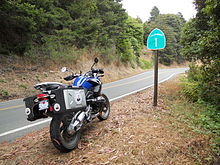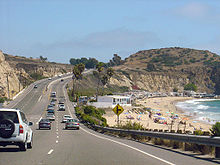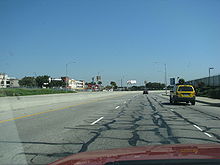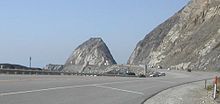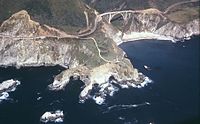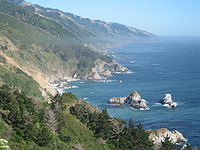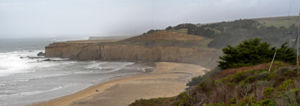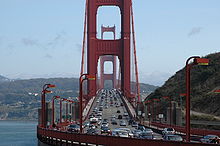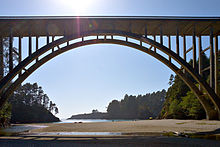- California State Route 1
-
For other uses, see CA1 (disambiguation).
State Route 1 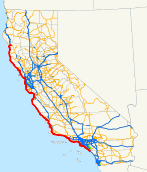
Route information Defined by S&HC § 301 Maintained by Caltrans Length: 655.843 mi[1] (1,055.477 km)
(broken into 5 pieces by U.S. Route 101)Existed: 1934 – present Major junctions South end:  I-5 in Dana Point
I-5 in Dana Point I-10 in Santa Monica
I-10 in Santa Monica
 SR 34 in Oxnard
SR 34 in Oxnard
 SR 46 near Cambria
SR 46 near Cambria
 SR 68 in Monterey
SR 68 in Monterey
 SR 17 in Santa Cruz
SR 17 in Santa Cruz
 I-280 in Daly City
I-280 in Daly City
 SR 20 near Fort Bragg
SR 20 near Fort BraggNorth end:  US 101 near Leggett
US 101 near LeggettHighway system State highways in California(list • pre-1964)
History • Unconstructed • Deleted • Freeway • Scenic←  I-980
I-980SR 2  →
→State Route 1 (SR 1), more often called Highway 1, is a state highway that runs along much of the Pacific coast of the U.S. state of California. It is famous for running along some of the most beautiful coastlines in the world, leading to its designation as an All-American Road.
Highway 1 does not run over the entire Pacific coastline of California. It starts at Interstate 5 (I-5) near Dana Point in Orange County and runs north to U.S. Highway 101 (US 101) near Leggett in Mendocino County. Highway 1 also at times runs concurrently with US 101, most notably through a 54-mile (87 km) stretch in Ventura and Santa Barbara Counties, and across the Golden Gate Bridge. It also serves as a scenic alternative in several locations; and a major thoroughfare in the Greater Los Angeles Area, the San Francisco Bay Area, and other coastal urban areas along its route.
Highway 1 has several portions designated as either Pacific Coast Highway (PCH), the Cabrillo Highway, the Shoreline Highway, or the Coast Highway.
Contents
Route description
Highway 1 is part of the California Freeway and Expressway System[2] and is eligible for the State Scenic Highway System.[3] However, only a few stretches between Los Angeles and San Francisco have officially been designated as a scenic highway.[4] The Big Sur section from San Luis Obispo to Carmel is an official National Scenic Byway.[5]
The entire route is also designated as a Blue Star Memorial Highway to recognize those in the United States armed forces. In Southern California, the California Legislature has designated the segment between Interstate 5 (I-5) in Dana Point and US 101 near Oxnard as the Pacific Coast Highway (commonly referred to as "PCH"). Between U.S. 101 at the Las Cruces junction (8 miles south of Buellton) and U.S. 101 in Pismo Beach, and between U.S. 101 in San Luis Obispo and Interstate 280 in San Francisco, the legislature has designated State Highway 1 as the Cabrillo Highway, after Portuguese explorer Juan Rodríguez Cabrillo. The legislature has also designated the route as the Shoreline Highway between the Manzanita Junction near Marin City and Leggett. Smaller segments of the highway have been assigned several other names by the state and municipal governments.[6]
In addition to connecting the coastal cities and communities along its path, Highway 1 also provides access to numerous beaches, parks, and other attractions along the coast, making it a popular route for tourists. The route runs right besides the coastline, or close to it, for the most part, but it also turns several miles inland to avoid several federally-controlled or protected areas such as Vandenberg Air Force Base, Diablo Canyon Power Plant and Point Reyes National Seashore.
Orange County
At its southernmost end in Orange County, Highway 1 terminates at I-5 in Capistrano Beach in Dana Point. It then travels north into the city center, where, for about 1 mile (1.6 km), northbound traffic continues along the original PCH alignment and southbound traffic is diverted onto the parallel Del Prado. After the two roads merge back, Highway 1 continues north along the coast through Laguna Beach and Crystal Cove State Park.
Highway 1 then enters Newport Beach, where it is known as simply Coast Highway. It passes through several affluent neighborhoods, including Newport Coast and Corona Del Mar, and spans the entrance to the Upper Newport Bay. Upon entering Huntington Beach, Highway 1 regains the Pacific Coast Highway designation. It passes Huntington State Beach before reaching Bolsa Chica State Beach and the Bolsa Chica Ecological Reserve. PCH then continues along the coast into Seal Beach, the final city on its journey in Orange County.
Los Angeles and Ventura counties
PCH enters Los Angeles County and the city of Long Beach after crossing the San Gabriel River. Highway 1 then continues northwest through the city to its junction with Lakewood Boulevard (State Route 19) and Los Coyotes Diagonal at the Long Beach Traffic Circle, more than 2 miles (3.2 km) from the coast. From the traffic circle, it continues inland west through Long Beach, including approximately one mile adjacent to the southern boundary of Signal Hill. PCH then passes through the Los Angeles districts of Wilmington and Harbor City. While bypassing the immediate coastline of Palos Verdes, Highway 1 continues to head west into the cities of Lomita and Torrance.
PCH then turns north through Redondo Beach and Hermosa Beach. Upon entering Manhattan Beach, it becomes Sepulveda Boulevard and continues through El Segundo and Los Angeles International Airport (LAX), passing under two runways via the Sepulveda Boulevard Tunnel.
After leaving LAX, State Highway 1 turns northwest, becoming Lincoln Boulevard and passing through the Los Angeles neighborhoods of Westchester, Playa Vista, Marina Del Rey, and Venice. It then enters the city of Santa Monica, where Highway 1 turns southwest, merging onto the final segment of the Santa Monica Freeway. Passing through the McClure Tunnel, Highway 1 emerges along the beachfront in Santa Monica and continues along the coast; it is known locally also as Palisades Beach Road and formerly as Roosevelt Highway. Upon leaving Santa Monica, it once again regains the name PCH as it follows the coast, curving west through the Pacific Palisades neighborhood before becoming Malibu's main thoroughfare, spanning the entire 21 miles (34 km) of that city.
After leaving Malibu, Highway 1 crosses into Ventura County and continues along the coast through Point Mugu State Park to just beyond the park's western boundary. Approaching the Oxnard Plain, it passes through a notch in the mountain that forms Point Mugu. The road cut left a very large rock formation at the tip of the point that is called the Mugu Rock. At that point, PCH leaves the coast and heads north, and then northwest as a freeway along the northeastern boundary of Naval Base Ventura County Point Mugu for several miles to an interchange at Rice Avenue, Pleasant Valley Road, and Oxnard Boulevard in Oxnard. From there, Highway 1 continues northwest onto Oxnard Boulevard to Wooley Road, then heads due north further inland to US 101, where it begins its first concurrency with that U.S. Route.
After traveling through Ventura, Highway 1 separates from US 101 to travel along the beach from Emma Wood State Beach to the Mobil Pier Undercrossing, where it rejoins US 101 about 3 miles (4.8 km) south of the Santa Barbara County line near La Conchita.
Central Coast and Big Sur
The US 101/Highway 1 concurrency (although actual signage mentioning Highway 1 through this segment is nonexistent) from the Mobil Pier Undercrossing runs for 54 miles (87 km), passing through the City of Santa Barbara and its neighboring communities along the coast of Santa Barbara County. Afterwards, Highway 1, now named Cabrillo Highway, splits again from US 101 north of the Gaviota Tunnel, and heads to the coastal city of Lompoc. It is briefly joined with Highway 246 along Lompoc's east-west Ocean Avenue, before turning north as H Street to Harris Grade Road, where it then regains the Cabrillo Highway name.
After reaching Vandenberg Air Force Base, Highway 1 turns inland, northeast, to join Highway 135. Route 135 then splits from Route 1 south of Orcutt, and the Cabrillo Highway turns northwest back towards the coast to Guadalupe. It then enters San Luis Obispo County, passing through Grover Beach before joining US 101 for the third time at Pismo Beach.
Highway 1 then splits from US 101 at San Luis Obispo and resumes as the Cabrillo Highway. It runs through Morro Bay as a freeway, where it crosses Morro Creek at the site of a prehistoric Chumash settlement dating to the Millingstone Horizon.[7] From there, Highway 1 proceeds north to Cayucos until it again becomes a winding, two lane road with occasional passing lanes. It then continues along the coast through San Simeon and past the elephant seal colony at Piedras Blancas Light.
Highway 1 then enters the Big Sur region, crossing the San Carpoforo Creek just south of the Monterey County line. For about 90 miles (140 km) from the San Carpoforo Creek to the Carmel River, the road winds and hugs the cliffs of Big Sur, passing various coastal parks in the area. This segment of the highway, built between 1919 and 1937, also crosses several historic bridges, including the scenic Bixby Creek Bridge, a reinforced concrete arch with a 320-foot (98 m) span that passes over the Bixby Creek gorge, and the Rocky Creek Bridge.
Monterey Bay area
After crossing the Carmel River, Highway 1 runs along just outside the eastern boundary of Carmel before becoming a freeway in Monterey. The freeway then heads north along the coast of Monterey Bay through Sand City, Seaside, and Marina. At the interchange with Highway 156 near Castroville, Highway 1 continues north as a two-lane rural road to Moss Landing.
Highway 1 becomes a freeway once again just before entering into Santa Cruz County. This four-lane freeway continues up the Monterey Bay through Watsonville to its interchange with Highway 17 in Santa Cruz (the Highway 1/17 interchange is locally known as The Fishhook due to its tight loop ramps that resemble a fishhook when viewed from above). Upon reaching downtown Santa Cruz, it continues as Mission Street and Coast Road, before regaining the Cabrillo Highway name after it leaves the city and continues north as a two lane road up the coast.
San Francisco Bay area
Entering San Mateo County, Highway 1 follows the west coast of the San Francisco Peninsula, passing by the marine mammal colonies at the Año Nuevo State Reserve, and the historic Pigeon Point Lighthouse, before reaching Half Moon Bay. Between Half Moon Bay and Pacifica, the highway travels through a treacherous stretch known as Devil's Slide, known for periodic landslides and closures.
Highway 1 then becomes a freeway once again at Sharp Park in Pacifica before turning inland to join Interstate 280 in Daly City. Just short of reaching the City and County of San Francisco, Highway 1 splits from Interstate 280, where the road becomes Junipero Serra Boulevard. Shortly thereafter, the highway makes a slight left, becoming the six-lane wide 19th Avenue. Highway 1 then turns into Park Presidio Boulevard after it passes through the city's Golden Gate Park. Then after entering the Presidio of San Francisco, it goes through the MacArthur Tunnel before joining US 101 for a fourth time on the approach to the Golden Gate Bridge known as Doyle Drive.
After crossing the bridge and entering Marin County, Highway 1 then splits from US 101 again near Marin City, where it leaves the city and, as the Shoreline Highway, returns to a winding, two lane road as it passes over the Marin Hills to rejoin the coast at Muir Beach. Leaving the Golden Gate National Recreation Area, the highway passes the Point Reyes National Seashore and Tomales Bay, eventually entering Sonoma County just south of Bodega Bay, where its name changes to Coast Highway past the Sonoma Coast State Beaches. After bridging the Russian River at Jenner, Highway 1 winds along the rugged coast to Fort Ross and Salt Point State Parks.
Mendocino County
Highway 1 then crosses the Gualala River and enters Mendocino County. The highway enters the city of Point Arena, in which it becomes Main Street, before following School Street to the northwest and then becoming Shoreline Highway once again. It bridges the Garcia River and then, near Elk, the Navarro River, where it meets Highway 128.
At the town of Albion, the Albion River is spanned by the Albion River Bridge, the only remaining wooden trestle bridge on the highway. Highway 1 then passes through Little River and Van Damme State Park, crosses Big River and passes through Mendocino Headlands State Park and the Victorian community of Mendocino. Continuing north, Highway 1 crosses Russian Gulch State Park on the Frederick W. Panhorst Bridge, and passes through the town of Caspar. Just south of the intersection with State Highway 20, a roundabout is under construction at Simpson Lane.[8][9] Highway 1 widens to two lanes at the western terminus of Highway 20, bridges the Noyo River at Noyo, and becomes Main Street of Fort Bragg, where it crosses the California Western Railroad.
North of Fort Bragg as a single-lane highway again, the highway passes MacKerricher State Park and the towns of Cleone and Inglenook before crossing Ten Mile River. At Rockport the highway turns away from the Lost Coast to avoid steep and unstable highlands created by Mendocino Triple Junction uplift. The highway follows Cottaneva Creek inland through redwood-forested mountainous terrain before terminating at US 101 just outside Leggett.
History
State construction of what is now Highway 1 started after the state's third highway bond issue passed in the 1900s – 1910s. At that time, California highways were not publicly referred to by any route numbers, and the Highway 1 name came about several years later. The legislature and Highway Department referred to roads either by a name or as "Legislative Route Numbers." The first two approved sections of what is now Highway 1 were Legislative Route 56 from San Simeon to Carmel (connecting with existing county highways at each end) and Legislative Route 60 from Oxnard via the coast to San Juan Capistrano, intended as links in a continuous coastal roadway from Oregon to Mexico.[10][11] A 1921 law extended Legislative Route 56 south over the county road to Cambria,[12] and Legislative Route 60 was extended from Oxnard to El Rio (midway to Ventura, now the site of the Oxnard Boulevard interchange with US 101) in 1925. The latter law, in theory, made Legislative Route 60 a continuous coastal loop, with both ends at what became US 101 in Oxnard and at Capistrano Beach (since 1964 the southern terminus of Highway 1 at Interstate 5 in Orange County).[13] Legislative Route 56 was extended further south from Cambria to connect to present-day US 101 in San Luis Obispo in 1931.[14]
A large expansion of the state highway system in 1933 resulted in Legislative Route Number 56 being extended in both directions. To the south, a second section was added, beginning at Pismo Beach on US 101 (Legislative Route 2) and heading south through Guadalupe and Lompoc to rejoin US 101 at a junction called Los Cruces (sic), just north of Gaviota Pass. (A short piece near Orcutt and Los Alamos had been part of Legislative Route Number 2, which originally followed present Highway 135 from Los Alamos to Santa Maria.) To the north, Legislative Route Number 56 was continued along the coast from Carmel through Santa Cruz to San Francisco. Several discontinuous pieces were added north of San Francisco, one from Legislative Route Number 1 (US 101) north of the Golden Gate to the county line near Valley Ford, another from the Russian River near Jenner (where the new Route 104 ended) to Westport, and a third from Ferndale to Route 1 near Fernbridge. Except for the gaps in Legislative Route Number 56 north of San Francisco, these additions completed the coastal highway, with other sections formed by Legislative Route Numbers 1, 2, and 71.[15][16]
Before the completion of its present alignment in 1937, a narrow, winding, steep road known as Pedro Mountain Road connected Montara with Pacifica. That highway was completed in 1914 and provided competition to the Ocean Shore Railroad, which operated between San Francisco and Tunitas Creek from 1907 to 1920. Highway 1 also used to run along the coast between Pacifica and Daly City but this segment was damaged and rendered unusable after a 5.3 magnitude earthquake on March 22, 1957. A small stub remains near Thornton Beach.
California Highway 1 is a famous brand name around the world now, but California 1 was called several other names and numbers prior to 1964. When the road was first envisioned in the World War I era, it was referred to either by a highway name or by a "Legislative Route Number" or LRN. LRNs were used by state highway planners and the Legislature from 1915 until 1964, but were never posted on highways, referred to by the auto clubs or public, nor used on maps. Various portions of State Highway 1 have been posted and referred to by various names and numbers over the years. The section of Highway 1 from Santa Monica to Oxnard, via Malibu, went out to contract in 1925 as "Coast Boulevard" but was designated "Theodore Roosevelt Highway" when it was dedicated in 1929.
California Highway 1 signs first went up after California decided to number its highways, in 1934. But only the section from Santa Barbara County north was posted as Highway 1, that section of the road known Legislative Route Number 56 (Las Cruces to Fernbridge, including the gaps). In Ventura, Los Angeles and Orange counties, Legislative Route Number 60 (San Juan Capistrano to the Oxnard area) became California Highway 3, and a few Route 3 signs were actually posted.[17] But the Route 3 signs were replaced by "U.S. Route 101 Alternate" shields and strips by 1936, as the road was built out; this change also allowed the extension of US 66 to end at another U.S. Route, in Santa Monica.[18]
The gaps of non-state highway along the northern coast were finally filled in by the Legislature in 1951, though the State Department of Public Works was not required to maintain the newly-added portions immediately. A short connection from near Rockport to Highway 1 at Leggett was also included,[19] as the existing county road north from Rockport to Ferndale had not yet been paved.[20] The Leggett connection became State Route 208.[21]
The state Legislature in 1963 tossed out the old conflicting Legislative Route Numbers (1964 renumbering), got rid of some famous old U.S. routes (like U.S. 66), and renumbered many state highways. It abolished US 101A in Los Angeles, Orange and Ventura counties and renumbered it as state Highway 1. The cover of "California Highways" magazine in fall 1964 shows state engineers posting the new shield at Point Mugu.[22] The same year, the Legislature by state law named Highway 1 "Pacific Coast Highway" in Orange, Los Angeles and Ventura counties, and "Cabrillo Highway" from San Luis Obispo north to San Francisco. Many cities, however, did not change the name of city streets that are part of Highway 1, such as Lincoln and Sepulveda boulevards in Los Angeles, Santa Monica and El Segundo; Oxnard Boulevard in Oxnard; and Junipero Serra and Park Presidio boulevards in San Francisco.
The freeway portion of Highway 1 from Highway 68 in Monterey to Munras Avenue opened in 1960. The segment from Munras Avenue to the northern border of Sand City and Seaside opened in 1968, and bypasses the original highway alignment of Munras Avenue and Fremont Street in Monterey, and Fremont Boulevard through Seaside. North of Seaside, the freeway was built over the original Highway 1 alignment through Fort Ord in 1973. North of Fort Ord, Highway 1 now veers to the left of the original alignment and bypasses Marina to the west. This segment including the interchange with Highway 156 and the short, 2-lane Castroville Bypass opened in 1976. Originally Highway 1 followed the Highway 156 alignment to the Highway 183 intersection in Castroville, then turned northwest, following the present-day Highway 183 through Castroville before rejoining its existing alignment at the northern terminus of the Castroville Bypass.
In 1980, another section was added northwest of Ventura, when several miles of the old two-lane alignment of US 101 were posted as Highway 1 where the freeway had bypassed it in about 1960. At its northern terminus, in 1984 State Highway 1 replaced State Highway 208, with the old alignment to Fernbridge, never constructed south of Ferndale, becoming State Highway 211.[23] This part of the Pacific coast, the only long section in California not served by a state highway, has been termed California's "Lost Coast".
For the 1932 Summer Olympics, the segment of the Highway 1 between Oxnard and Santa Monica (then known as the Theodore Roosevelt Highway) hosted part of the road cycling events.[24]
Maintenance
Frequent California landslides and erosion along the coast have caused portions of Highway 1 to either be closed for long periods of time, or be re-routed entirely. Some of these examples include:
- A segment right along the coast between Pacifica and Daly City in what is now Thornton Beach was damaged and rendered unusable after a 5.3 magnitude earthquake on March 22, 1957. Highway 1 was then eventually re-routed to turn inland to join Interstate 280.
- The Piedras Blancas Realignment Project plans to re-route the road up to 475 feet further inland to avoid the expected coastal erosion from the Piedras Blancas Lighthouse to the Arroyo de la Cruz Bridge in San Luis Obispo County.[25]
- The Devil's Slide area has also been prone to major landslides. One in 1995 caused the road to be closed for five months, while another in 2006 led to a four-month closure.[26] A tunnel to bypass the area is scheduled to open by the end of 2011.[27]
- Major reconstruction is also planned between Muir Beach and Stinson Beach, including the addition of a 523-foot-long, 20-foot-high, but mostly buried, retaining wall. This follows a four-month, $25 million reconstruction that repaired damage from a 2007 landslide.[28]
- A March 2011 landslide in the Big Sur region forced the highway to be closed for several months.[29][30]
Other future projects
There is a future plan to re-route Highway 1 in Oxnard. Once a new Rice Avenue-US 101 interchange is completed, PCH between Pleasant Valley Road and US 101 will be moved from Oxnard Blvd onto Rice.
Major intersections
- Note: Except where prefixed with a letter, postmiles were measured in 1964, based on the alignment as it existed at that time, and do not necessarily reflect current mileage. The numbers reset at county lines; the start and end postmiles in each county are given in the county column.
County Location Postmile
[1][31][32]Exit
[33][34]Destinations Notes Orange
ORA R0.13-33.72Dana Point R0.13 Camino Las Ramblas Continuation beyond I-5 R0.13  I-5 (San Diego Freeway) – Los Angeles, San Diego
I-5 (San Diego Freeway) – Los Angeles, San DiegoInterchange South end of freeway R0.78 Coast Highway south, Doheny Park Road – Capistrano Beach North end of freeway 4.32 Crown Valley Parkway, Monarch Bay Drive Laguna Beach 9.42  SR 133 (Broadway Street) to Laguna Canyon Road
SR 133 (Broadway Street) to Laguna Canyon RoadNewport Beach  Newport Coast Drive to SR 73
Newport Coast Drive to SR 7316.25  MacArthur Boulevard to I-405 – Long Beach, Los Angeles, Santa Ana
MacArthur Boulevard to I-405 – Long Beach, Los Angeles, Santa AnaFormer SR 73 north; serves John Wayne Airport 17.43 Jamboree Road – Balboa Island 19.80  SR 55 (Newport Boulevard) – Costa Mesa, Balboa Peninsula
SR 55 (Newport Boulevard) – Costa Mesa, Balboa PeninsulaInterchange Huntington Beach 22.09 Brookhurst Street – Fountain Valley 23.74  SR 39 north (Beach Boulevard)
SR 39 north (Beach Boulevard)25.89 Goldenwest Street Interchangeably spelled Golden West Street Sunset Beach 29.89 Warner Avenue Seal Beach 32.72 Seal Beach Boulevard – Los Alamitos Los Angeles
LA 0.00-62.69Long Beach 2nd Street 1.97  SR 22 (7th Street)
SR 22 (7th Street)2.75 Anaheim Street, Los Altos Plaza 3.56 Lakewood Boulevard, Los Coyotes Diagonal – Downey, Bellflower Lakewood Boulevard was former SR 19 north 6.26 Long Beach Boulevard 7.29  I-710 (Long Beach Freeway) – Long Beach, Pasadena
I-710 (Long Beach Freeway) – Long Beach, PasadenaInterchange 8.27  SR 103 (Terminal Island Freeway) / Willow Street – Terminal Island
SR 103 (Terminal Island Freeway) / Willow Street – Terminal IslandInterchange Los Angeles 8.43 2200-2400 East Pacific Coast Highway – Port of Los Angeles Interchange 9.25 Alameda Street (SR 47) via O Street Interchange 10.53 Avalon Boulevard 11.61  I-110 (Harbor Freeway) – Los Angeles, San Pedro
I-110 (Harbor Freeway) – Los Angeles, San PedroInterchange 12.17 Vermont Avenue 12.52 Normandie Avenue 13.10  SR 213 (Western Avenue)
SR 213 (Western Avenue)Torrance 14.63 Crenshaw Boulevard – Rolling Hills 16.01 
 SR 107 north / CR N7 (Hawthorne Boulevard) – Inglewood, Palos Verdes Estates
SR 107 north / CR N7 (Hawthorne Boulevard) – Inglewood, Palos Verdes EstatesRedondo Beach 19.52 Torrance Boulevard Manhattan Beach 21.92 Artesia Boulevard, Gould Avenue Artesia Boulevard was former SR 91 east 22.90 Manhattan Beach Boulevard 23.92 Rosecrans Avenue El Segundo 24.91 El Segundo Boulevard Los Angeles 25.92  I-105 east (Century Freeway) / Imperial Highway – Norwalk
I-105 east (Century Freeway) / Imperial Highway – NorwalkInterchange 26.90 Century Boulevard – LAX Airport Interchange 27.36 LAX Airport (96th Street) Interchange Sepulveda Boulevard No left turn from SR 1 south 28.50 Westchester Parkway Interchange 29.08 Manchester Avenue – Playa del Rey Former SR 42 east 31.29  SR 90 east (Marina Freeway)
SR 90 east (Marina Freeway)31.78 Washington Boulevard 32.17 Venice Boulevard (SR 187 east) – Culver City, Venice Santa Monica R34.58 
 I-10 east (Santa Monica Freeway) / SR 2 east (Lincoln Boulevard) – Los Angeles
I-10 east (Santa Monica Freeway) / SR 2 east (Lincoln Boulevard) – Los AngelesInterchange South end of freeway North end of freeway 35.18 Ocean Avenue Interchange; southbound exit and northbound entrance; former SR 187 east Los Angeles 39.33 Sunset Boulevard 40.77  SR 27 north (Topanga Canyon Boulevard)
SR 27 north (Topanga Canyon Boulevard)Malibu 48.17  CR N1 (Malibu Canyon Road)
CR N1 (Malibu Canyon Road)54.02  CR N9 north (Kanan Dume Road) to Ventura Freeway
CR N9 north (Kanan Dume Road) to Ventura Freeway59.90  SR 23 north (Decker Canyon Road) – Thousand Oaks
SR 23 north (Decker Canyon Road) – Thousand Oaks62.30 Mulholland Highway Ventura
VEN 0.00-43.62[N 1]South end of freeway 10.23 107 Las Posas Road – USN Point Mugu 11.59 108 Wood Road – USN Point Mugu 12.79 109 Hueneme Road Oxnard 13.59 110 Nauman Road No entrance ramps to SR 1; no access across SR 1 R14.67 Hueneme Road Southbound exit and northbound entrance North end of freeway 15.06 Rice Avenue, Pleasant Valley Road South end of freeway 15.93 113 Channel Islands Boulevard Southbound exit is via Rose Avenue North end of freeway 16.21 Rose Avenue No left turns from SR 1 17.63 Saviers Road, Wooley Road Saviers Road was former SR 34 west 18.15  SR 34 east (Fifth Street)
SR 34 east (Fifth Street)20.14 
 SR 232 north (Vineyard Avenue) to US 101 south – Los Angeles
SR 232 north (Vineyard Avenue) to US 101 south – Los Angeles21.08
22.73[N 1] US 101 south (Ventura Freeway) / Oxnard Boulevard – Los Angeles
US 101 south (Ventura Freeway) / Oxnard Boulevard – Los AngelesInterchange; south end of US 101 overlap South end of freeway on US 101 63A Ventura Road Southbound exit only Ventura R23.45[N 1] 63B Johnson Drive – Montalvo Signed as exit 63 northbound R24.65[N 1] 64 Victoria Avenue – Channel Island Harbor 25.97[N 1] 65 Telephone Road 26.39[N 1] 66A  SR 126 east (Santa Paula Freeway) – Santa Clarita
SR 126 east (Santa Paula Freeway) – Santa ClaritaSigned as exit 66 southbound; no southbound entrance 26.72[N 1] 66B Main Street (US 101 Bus. north) – Ventura No southbound exit 28.45[N 1] 68 Seaward Avenue 29.45[N 1] 69 Vista del Mar Drive, Sanjon Road Northbound exit and southbound entrance 30.15[N 1] 70A California Street, Ventura Avenue 30.91[N 1] 70B  SR 33 north (Ojai Freeway) – Ojai
SR 33 north (Ojai Freeway) – OjaiFormer US 399 31.50[N 1] 71 Main Street (US 101 Bus. south) – Ventura Southbound exit and northbound entrance North end of freeway on US 101 Solimar Beach R32.70[N 1]
21.25 US 101 north (Ventura Freeway)
US 101 north (Ventura Freeway)Interchange; northbound exit and southbound entrance; north end of US 101 overlap Seacliff 27.68
R38.98[N 1] US 101 south (Ventura Freeway) – Los Angeles
US 101 south (Ventura Freeway) – Los AngelesInterchange; south end of US 101 overlap South end of freeway on US 101 R43.57[N 1] 83 Bates Road Santa Barbara
SB R0.00[N 1]-50.61Carpinteria R0.63[N 1] 84  SR 150 east – Ojai, Lake Casitas
SR 150 east – Ojai, Lake Casitas1.61[N 1] 85 Bailard Avenue 2.64[N 1] 86A Casitas Pass Road Signed as exit 86 northbound 3.06[N 1] 86B Linden Avenue Southbound exit and northbound entrance 3.77[N 1] 87A Santa Monica Road Signed as exit 87 northbound 87B Carpinteria Avenue Southbound exit only R5.28[N 1] 88 Padaro Lane, Santa Claus Lane R7.14[N 1] 90 Padaro Lane – Summerland R8.26[N 1] 91 Evans Avenue – Summerland Montecito 9.00[N 1] 92 Sheffield Drive 10.02[N 1] 93 San Ysidro Road Santa Barbara 10.54[N 1] 94A Olive Mill Road, Coast Village Road No northbound entrance 94B Hermosillo Drive Northbound exit only 11.41[N 1] 94C Hot Springs Road, Cabrillo Boulevard, Coast Village Road Signed as exit 94B southbound 95 Los Patos Way Southbound exit only; unsigned 95 Salinas Street Northbound exit and entrance 12.75[N 1] 96A Milpas Street Former SR 144 13.49[N 1] 96B Laguna Street, Garden Street R14.19[N 1] 97 Bath Street, Castillo Street – Santa Barbara Harbor R14.76[N 1] 98A Carrillo Street – Downtown Santa Barbara Signed as exit 98 southbound R15.26[N 1] 98B Arrellaga Street Northbound exit and entrance R15.73[N 1] 99A Mission Street Signed as exit 99 southbound 99B Pueblo Street Northbound exit only 16.55[N 1] 100  SR 225 east (Las Positas Road)
SR 225 east (Las Positas Road)17.78[N 1] 101A La Cumbre Road, Hope Avenue 18.38[N 1] 101B  SR 154 west / State Street – Cachuma Lake
SR 154 west / State Street – Cachuma Lake102 El Sueno Road Northbound exit and entrance 20.06[N 1] 103 Turnpike Road Goleta 21.15[N 1] 104A Patterson Avenue Signed as exit 104 southbound 21.41[N 1] 104B  SR 217 west – Airport, UCSB
SR 217 west – Airport, UCSBNorthbound exit and southbound entrance 22.53[N 1] 105 Fairview Avenue 23.72[N 1] 107 Los Carneros Road 24.77[N 1] 108 Glen Annie Road, Storke Road 26.91[N 1] 110 Winchester Canyon Road, Hollister Avenue Short gap in freeway on US 101 30.06[N 1] 113 Dos Pueblos Canyon Road Short gap in freeway on US 101 32.84[N 1] 116 El Capitan Ranch Road 33.85[N 1] 117 El Capitan State Beach 36.62[N 1] 120 Refugio Road – Refugio State Beach North end of freeway on US 101 44.82[N 1] 128 Mariposa Reina Interchange Gaviota State Beach 47.19[N 1] Gaviota Gorge Tunnel (northbound only) South end of freeway on US 101 North end of freeway on US 101 Las Cruces R48.85[N 1]
R0.00 US 101 north – San Luis Obispo, San Francisco
US 101 north – San Luis Obispo, San FranciscoInterchange; north end of US 101 overlap Santa Rosa Road Lompoc 19.25  SR 246 east / 12th Street – Buellton
SR 246 east / 12th Street – BuelltonSouth end of SR 246 overlap 20.57  SR 246 west (Ocean Avenue) / H Street – NASA South Gate, Surf
SR 246 west (Ocean Avenue) / H Street – NASA South Gate, SurfNorth end of SR 246 overlap 23.30 Harris Grade Road, Purisima Road – Buellton Vandenberg Village R25.07 211 Constellation Road Interchange Santa Lucia Canyon Road M29.89 California Boulevard, Lompoc Casmalia Road – Vandenberg AFB San Antonio Road West – Casmalia San Antonio Road East – Los Alamos M36.19
R31.04 SR 135 south – Los Alamos
SR 135 south – Los AlamosInterchange; southbound exit and northbound entrance; south end of SR 135 overlap South end of freeway R34.78 226  SR 135 north – Orcutt, Santa Maria
SR 135 north – Orcutt, Santa MariaNorthbound exit and southbound entrance; north end of SR 135 overlap North end of freeway R35.53  Clark Avenue to SR 135 north – Orcutt
Clark Avenue to SR 135 north – OrcuttBlack Road – Casmalia, Vandenberg, Betteravia Guadalupe 49.20  SR 166 east (Main Street) – Santa Maria
SR 166 east (Main Street) – Santa MariaSan Luis Obispo
SLO 0.00-74.32Division Street – Nipomo Pismo Beach L16.54
17.75[N 1] US 101 south
US 101 southInterchange; south end of US 101 overlap South end of freeway on US 101 R19.81[N 1] 193 Spyglass Drive, Shell Beach Road R21.11[N 1] 195 Avilla Beach Drive R22.29[N 1] 196 San Luis Bay Drive – See Canyon, Avila Beach R24.30[N 1] 198 Higuera Street San Luis Obispo 25.91[N 1] 200A Los Osos Valley Road Signed as exit 200 southbound 200B Prado Road, Elks Lane Northbound exit and entrance 27.50[N 1] 201  SR 227 south (Madonna Road)
SR 227 south (Madonna Road)28.07[N 1] 202A Marsh Street 28.81[N 1] 202B Broad Street 29.08[N 1] 203A Osos Street, Santa Rosa Street North end of freeway on US 101 29.08[N 1]
16.77 US 101 / Santa Rosa Street
US 101 / Santa Rosa StreetInterchange; north end of US 101 overlap South end of freeway Morro Bay 27.88 277 Los Osos/Baywood Park (South Bay Boulevard) 28.82 278 Morro Bay Boulevard 29.62 279A Main Street 30.14 279B  SR 41 north – Atascadero
SR 41 north – AtascaderoShort gap in freeway R34.91 284 Cayucos (13th Street) Northbound exit and southbound entrance R35.96 285 Cayucos Drive North end of freeway 45.99  SR 46 east (Green Valley Road) – Paso Robles
SR 46 east (Green Valley Road) – Paso RoblesCambria 48.26 
 SR 1 Bus. north (Main Street) / Ardath Drive – Cambria
SR 1 Bus. north (Main Street) / Ardath Drive – Cambria
 SR 1 Bus. south (Windsor Boulevard) to Moonstone Beach Drive – Cambria
SR 1 Bus. south (Windsor Boulevard) to Moonstone Beach Drive – Cambria56.39 Hearst Castle Monterey
MON 0.00-R102.0372.92  CR G16 (Carmel Valley Road)
CR G16 (Carmel Valley Road)South end of freeway Monterey 75.14 399A  SR 68 west – Pacific Grove, Pebble Beach
SR 68 west – Pacific Grove, Pebble BeachSouth end of SR 68 overlap R75.75 399B Munras Avenue – Monterey No northbound entrance R76.00 399C Soledad Drive, Munras Avenue Southbound exit and northbound entrance R77.38 401A Aguajito Road – Monterey R78.12 401B  SR 68 east – Salinas
SR 68 east – SalinasNorth end of SR 68 overlap R78.18 401B North Fremont Street Northbound exit and southbound entrance R78.45 402A Casa Verde Way R78.88 402B Del Monte Avenue – Pacific Grove Seaside R79.36 403  SR 218 east (Canyon del Rey Boulevard) – Seaside, Del Rey Oaks
SR 218 east (Canyon del Rey Boulevard) – Seaside, Del Rey OaksSand City R80.27 404 Fremont Boulevard, Del Monte Boulevard – Seaside, Sand City R82.89 406 Lightfighter Drive R84.48 408 12th Street R85.14 409 Marina (Del Monte Boulevard) Northbound exit and southbound entrance R86.48 410 Reservation Road – Marina R88.64 412 Del Monte Boulevard – Marina R90.39 414A Nashua Road, Molera Road Signed as exit 414 southbound R90.98 414B 
 SR 156 east to US 101 – Castroville, San Jose
SR 156 east to US 101 – Castroville, San JoseNorthbound exit and southbound entrance North end of freeway T92.21 
 SR 183 south (Merritt Street) to SR 156 east – Castroville, Salinas
SR 183 south (Merritt Street) to SR 156 east – Castroville, SalinasSanta Cruz
SCR R0.00-37.45South end of freeway R0.72 425 
 SR 129 east (Riverside Drive) to SR 152 east – Watsonville
SR 129 east (Riverside Drive) to SR 152 east – WatsonvilleWatsonville R2.27 426 Harkins Slough Road, Green Valley Road Northbound exit and southbound entrance R2.68 426  SR 152 east (Main Street) – Watsonville, Gilroy
SR 152 east (Main Street) – Watsonville, GilroySouthbound exit and northbound entrance R3.18 427 Airport Boulevard – Freedom Serves Watsonville Municipal Airport R4.07 428 Buena Vista Drive R6.69 431 Mar Monte Avenue – La Selva R7.66 432 San Andreas Road, Larkin Valley Road 8.35 433A Freedom Boulevard 9.15 433B Rio del Mar Boulevard – Rio del Mar, Aptos 10.54 435 State Park Drive – Seacliff Beach, Aptos Capitola 12.09 436 Park Avenue – Capitola, New Brighton Beach 13.19 437 Porter Street, Bay Avenue 13.62 438 41st Avenue 14.86 439 Soquel Drive, Soquel Avenue Santa Cruz 15.82 440 Morrissey Boulevard 16.63 441A Emeline Avenue Northbound exit only 16.82 441B  SR 17 north – San Jose, Oakland
SR 17 north – San Jose, OaklandSigned as exit 441 southbound 17.24 442 Ocean Street – Beaches North end of freeway 17.56  SR 9 north (River Street) – Boulder Creek, Big Basin, Downtown Santa Cruz
SR 9 north (River Street) – Boulder Creek, Big Basin, Downtown Santa Cruz19.00 Bay Street – UC Santa Cruz San Mateo
SM 0.00-R48.5613.58 Pescadero Road, Pescadero State Beach San Gregorio 18.19  SR 84 north – San Gregorio, La Honda, Redwood City
SR 84 north – San Gregorio, La Honda, Redwood CityHalf Moon Bay 29.04  SR 92 east – San Mateo
SR 92 east – San MateoSouth end of freeway Pacifica R43.46 505A Sharp Park Boulevard, Fairway Drive – San Bruno Signed as exit 505 southbound R43.74 505B Clarendon Road, Oceana Boulevard Northbound exit only R44.21 506 Paloma Avenue, Francisco Boulevard Southbound exit and northbound entrance R45.12 507 Manor Drive, Monterey Road, Palmetto Avenue Daly City R46.72 508  SR 35 (Skyline Boulevard)
SR 35 (Skyline Boulevard)Signed as exit 508A (south) and 508B (north) southbound R47.27 509A Serramonte Boulevard, Clarinada Avenue Signed as exit 509 southbound R47.80
R25.28[N 2]509B  I-280 south (Junipero Serra Freeway) – San Jose
I-280 south (Junipero Serra Freeway) – San JoseSouth end of I-280 overlap; no exit number southbound R25.78[N 2] 510 Eastmoor Avenue, Mission Street Signed as exit 48 southbound M27.17[N 2]
R48.05 I-280 north – Downtown San Francisco, Bay Bridge
I-280 north – Downtown San Francisco, Bay BridgeNorth end of I-280 overlap; southbound exit is exit 511 511 John Daly Boulevard – Daly City, Westlake District Signed as exit 49A northbound San Francisco
SF R0.00-11.18[N 1]North end of freeway R0.11 Alemany Boulevard east – Cow Palace Interchange R0.31 Brotherhood Way Interchange R0.68 Junipero Serra Boulevard – San Francisco State University, San Francisco Zoo No left turn from SR 1 south to Junipero Serra Boulevard north 1.90  SR 35 south (Sloat Boulevard) – San Francisco Civic Center, Beach, San Francisco Zoo
SR 35 south (Sloat Boulevard) – San Francisco Civic Center, Beach, San Francisco ZooNo left turn from SR 1 north to Sloat Boulevard west (SR 35) 4.05 Lincoln Way No left turns from SR 1 Geary Boulevard – University of San Francisco No left turns from SR 1 South end of freeway 7.08
9.60[N 1] US 101 south / Marina Boulevard – Downtown San Francisco
US 101 south / Marina Boulevard – Downtown San FranciscoSouth end of US 101 overlap; US 101 south was former SR 480 east 9.71[N 1] 439 25th Avenue – View Area, Presidio, Golden Gate NRA, Fort Point Golden Gate Bridge over Golden Gate Marin
MRN L0.00[N 1]-50.51Sausalito Vista Point Northbound exit and entrance 0.32[N 1] 442 Alexander Avenue – Sausalito 0.89[N 1] Waldo Tunnel through Waldo Grade 1.52[N 1] 443 Spencer Avenue, Monte Mar Drive 2.48[N 1] 444 Rodeo Avenue No access across US 101 3.33[N 1] 445A Sausalito, Marin City North end of freeway on US 101 4.46[N 1]
0.00 US 101 north – Santa Rosa
US 101 north – Santa RosaInterchange; north end of US 101 overlap 0.65 Almonte Boulevard – Mill Valley Olema 26.51 Sir Francis Drake Boulevard Point Reyes Station 29.33 Point Reyes Petaluma Road – Petaluma Sonoma
SON 0.00-58.580.19 Valley Ford Road – Petaluma 2.42 Valley Ford Freestone Road – Occidental, Monte Rio 5.38 Bodega Highway – Bodega, Sebastopol 20.10  SR 116 east (River Road) – Guerneville
SR 116 east (River Road) – GuernevilleFort Ross R33.04 Fort Ross Road – Cazadero, Fort Ross Mendocino
MEN 0.00-105.58Point Arena 15.18 Riverside Drive 40.27  SR 128 – Cloverdale
SR 128 – CloverdaleFort Bragg 59.80  SR 20 – Willits
SR 20 – Willits90.87  SR 211 (Usal Road)
SR 211 (Usal Road)105.50  SR 271 – Leggett
SR 271 – Leggett105.58  US 101 – Ukiah, Eureka, Crescent City
US 101 – Ukiah, Eureka, Crescent City1.000 mi = 1.609 km; 1.000 km = 0.621 mi
Concurrency terminus • Closed/Former • Incomplete access • Unopened- ^ a b c d e f g h i j k l m n o p q r s t u v w x y z aa ab ac ad ae af ag ah ai aj ak al am an ao ap aq ar as at au av aw ax ay az ba bb bc bd be bf bg bh bi bj bk bl bm bn bo bp bq br bs bt Indicates that the postmile represents the distance along US 101 rather than SR 1.
- ^ a b c Indicates that the postmile represents the distance along I-280 rather than SR 1.
See also
References
- ^ a b California Department of Transportation, State Truck Route List (XLS file), accessed December 2007
- ^ CA Codes (shc:250-257)
- ^ CA Codes (shc:260-284)
- ^ California Department of Transportation, Officially Designated Scenic Highways, accessed 2009-09-14
- ^ National Scenic Byways Program: Big Sur Coast Highway
- ^ 2007 Named Freeways, Highways, Structures and Other Appurtenances in California. Caltrans. pp. 115–116. http://www.dot.ca.gov/hq/tsip/hseb/products/Named_Freeways.pdf. Retrieved 2007-03-28.
- ^ Hogan, C.Michael (2008-02-25). "Morro Creek - Ancient Village or Settlement in United States in The West". The Megalithic Portal. http://www.megalithic.co.uk/article.php?sid=18502. Retrieved 2011-07-04.
- ^ "Fort Bragg’s $4.4 million roundabout". Santa Rosa Press-Democrat. May 18, 2011. http://roadwarrior.blogs.pressdemocrat.com/12572/fort-braggs-4-4-million-roundabout/.
- ^ Caltrans: Simpson Lane Intersection, retrieved 2011-07-07.
- ^ Ben Blow, California Highways: A Descriptive Record of Road Development by the State and by Such Counties as Have Paved Highways, 1920 (Archive.org or Google Books), pp. 182, 232-233, 249
- ^ Howe & Peters, Engineers' Report to California State Automobile Association Covering the Work of the California Highway Commission for the Period 1911-1920, pp. 11-16
- ^ "An act declaring the county road extending from San Simeon to Cambria to be a state highway and providing for the maintenance thereof.", 1921 chapter 837, p. 1606
- ^ "An act...to construct and maintain...a state highway, extending from the town of Oxnard to a point...at or near the town of El Rio, Ventura county.", 1925 chapter 309, p. 508
- ^ "An act establishing certain additional state highways and classifying them as secondary highways.", 1931 chapter 82, p. 103
- ^ "An act...relating to...the addition of certain highways to the State system.", 1933 chapter 767, p. 2034-2039: "Ferndale to State Highway Route 1 near Fernbridge." "Russian River near Jenner to Westport." "State Highway near southerly end of Marin Peninsula to the Marin-Sonoma County line via the Coast Route." "Santa Cruz to San Francisco via Coast." "State Highway Route 56 near Carmel to Santa Cruz." "State Highway Route 2 near Las Cruces via Lompoc and Guadalupe to State Highway Route 2 near Pismo."
- ^ "An act to establish a Streets and Highways Code...", 1935 chapter 29, p. 279: "Route 56 is from: (a) Route 2 near Los [sic] Cruces via Lompoc and Guadalupe to Route 2 near Pismo. (b) San Luis Obispo to San Francisco along the coast via Cambria, San Simeon, Carmel, and Santa Cruz. (c) State Highway near southerly end of Marin Peninsula to the Marin-Sonoma County line via the Coast Route. (d) Russian River near Jenner to Westport. (e) Ferndale to Route 1 near Fernbridge." "Route 60 is from Route 2 near El Rio via Oxnard to Route 2 south of San Juan Capistrano."
- ^ California Highways and Public Works, State Routes will be Numbered and Marked with Distinctive Bear Signs, August 1934
- ^ Automobile Club of Southern California, Automobile route along the Pacific coast from Seal Beach to Santa Monica, 1936
- ^ "An act to amend Section 356 of the Streets and Highways Code, relating to state highways.", 1951 chapter 1588, p. 3585
- ^ H.M. Gousha Company, Highway Map of California, 1955
- ^ "An act...relating to routes on the state highway system.", 1963 chapter 385, p. 1171, 1186
- ^ California Highways magazine, Sept. 1964
- ^ "An act...relating to state highways.", 1984 chapter 409, p. 1769, 1774
- ^ 1932 Summer Olympics official report. p. 87.
- ^ CalTrans5: Piedras Blancas Realignment Project
- ^ Cabanatuan, Michael (2010-06-19). "Major progress on Devil's Slide tunnel". San Francisco Chronicle. http://www.sfgate.com/cgi-bin/article.cgi?file=/c/a/2010/06/19/MNUM1E1069.DTL. Retrieved 2011-08-14.
- ^ CalTrans4: Devil's Slide Project
- ^ Johnson, Nate (2010-05-31). "Highway 1 repair plan near Stinson outlined". Oakland Tribune. http://www.insidebayarea.com/ci_15195448. Retrieved 2011-08-14.
- ^ "Highway 1 To Be Closed At Least 1 Month". KSBW. 2011-03-18. http://www.ksbw.com/news/27237744/detail.html. Retrieved 2011-08-14.
- ^ "Landslide shuts famed Californian Highway 1 as big chunk falls into the sea". Daily Mail. 2011-03-18. http://www.dailymail.co.uk/news/article-1367404/Landslide-shuts-Californian-Highway-1-big-chunk-falls-sea.html#ixzz1V2aC13XT. Retrieved 2011-08-14.
- ^ California Department of Transportation, Log of Bridges on State Highways, July 2007
- ^ California Department of Transportation, All Traffic Volumes on CSHS, 2005 and 2006
- ^ California Department of Transportation, California Numbered Exit Uniform System, State Route 1 Freeway Interchanges, Retrieved on 2009-02-05.
- ^ California Department of Transportation, California Numbered Exit Uniform System, U.S. Route 101 Freeway Interchanges, Retrieved on 2009-02-05.
External links
- Pacific Coast Highway Travel
- California @ WestCoastRoads - State Route 1
- Caltrans: Route 1 road conditions
- California Highways: SR 1
- 1958 plans for the conversion of Junipero Serra Boulevard in San Francisco to freeway
- 1964 plans for the conversion of Park Presidio Boulevard in San Francisco to freeway
San Francisco Bay Area Freeways Italics denote former routes.Interstates and U.S. Routes I-80 (James Lick / Eastshore / San Francisco Skyway) · US 101 (South Valley / Bayshore / Redwood Highway / Central) · I-238 · I-280 (Junipero Serra / Southern / Sinclair) · I-380 (Kopp) · CA 480 (Embarcadero) · I-580 (MacArthur) · I-680 (Sinclair) · I-780 · I-880 (Nimitz Freeway) · I-980 (Grove-Shafter)
California State Routes CA 1 (Cabrillo Highway) · CA 4 (John Muir Parkway) · CA 12 (Burbank Freeway) · CA 13 (Warren Freeway) · CA 17 (Santa Cruz Highway) · CA 24 (Grove-Shafter Freeway) · CA 29 (Vallejo-Napa Freeway) · CA 37 (Sears Point Freeway/Marine World Parkway) · CA 84 (Dumbarton Bridge) · CA 85 (West Valley Freeway) · CA 87 (Guadalupe Freeway) · CA 92 (San Mateo-Hayward Bridge/Younger Freeway) · CA 160 (Antioch Bridge) · CA 237 (South Bay Freeway) · CA 242 (Concord Freeway)Named interchanges Bridges Golden Gate Bridge · San Francisco – Oakland Bay Bridge · San Mateo – Hayward Bridge · Dumbarton Bridge · Richmond – San Rafael Bridge · Carquinez Bridge · Benicia–Martinez Bridge · Antioch BridgeSee also Venues of the 1932 Summer Olympics 160th Regiment State Armory · Los Angeles Harbor · Los Angeles Police Pistol Range · Olympic Auditorium · Long Beach Marine Stadium · Los Angeles Avenue · Olympic Stadium · Pacific Coast Highway · Riverside Drive at Griffith Park · Riviera Country Club · Rose Bowl in Pasadena · Sunset Fields Golf Club · Swimming Stadium · Vineyard Avenue · WestchesterCategories:- 1932 Summer Olympic venues
- State highways in California
- All-American Roads
- Juan Bautista de Anza National Historic Trail
- San Francisco Bay Area freeways
- Southern California freeways
- Freeways in California
- Roads in Orange County, California
- Roads in Los Angeles County, California
- Roads in Ventura County, California
- Roads in Santa Barbara County, California
- Roads in San Luis Obispo County, California
- Roads in Monterey County, California
- Roads in Santa Cruz County, California
- Roads in San Mateo County, California
- Roads in San Francisco, California
- Roads in Marin County, California
- Roads in Sonoma County, California
- Roads in Mendocino County, California
- Scenic highways in California
- Monuments and memorials in California
- Blue Star Memorial Highways
- Olympic cycling venues
- California State Route 1
Wikimedia Foundation. 2010.


